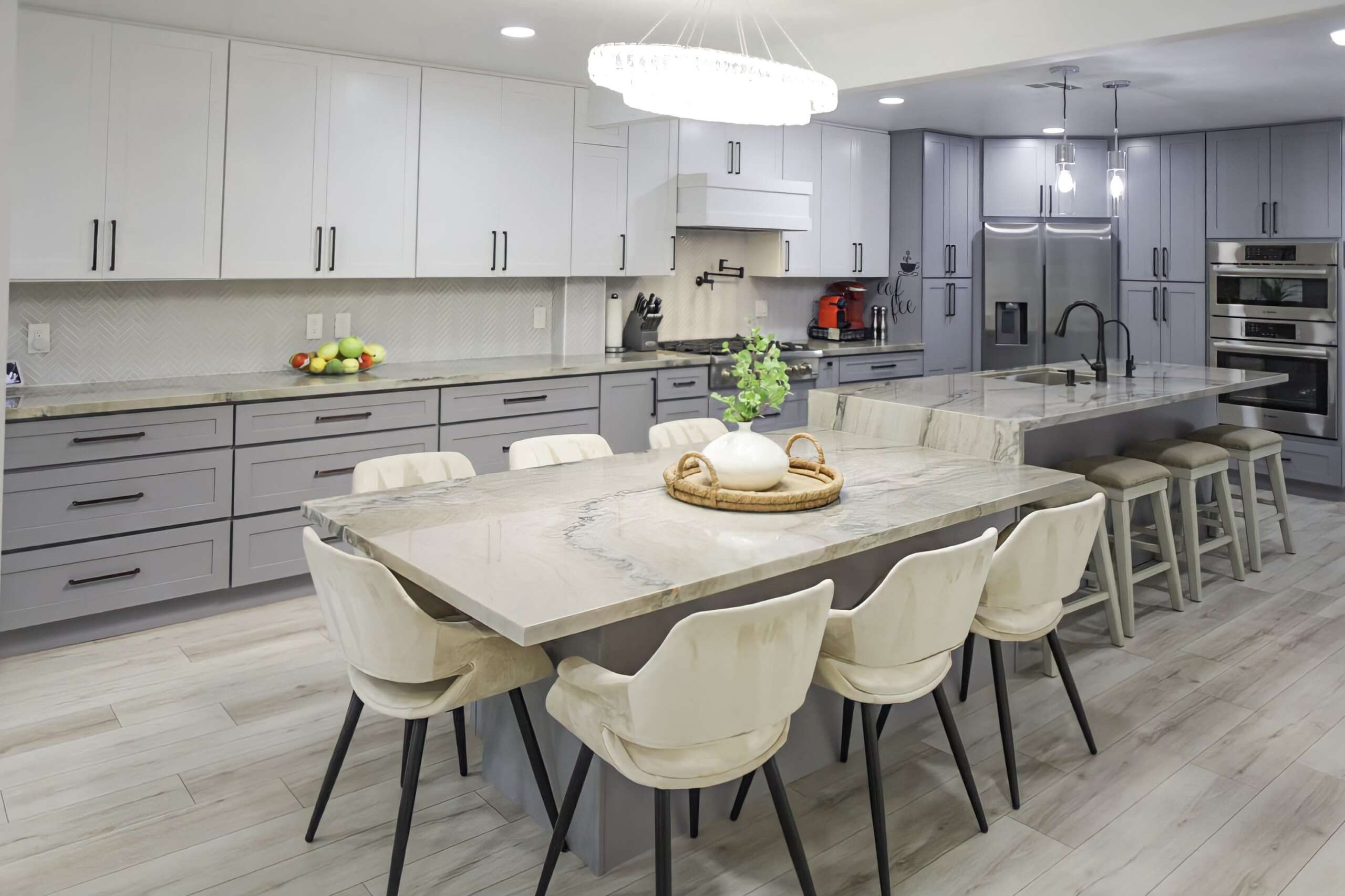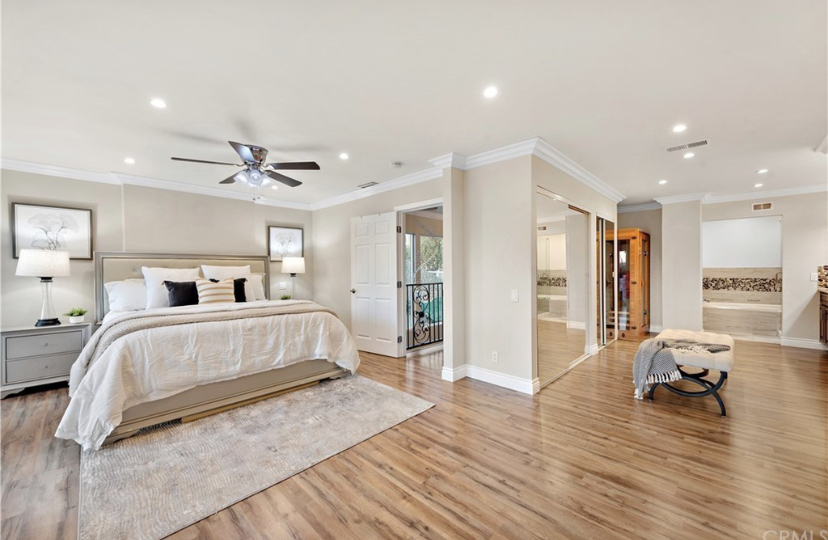The kitchen is a high foot-traffic zone for most households. Whether it’s mom’s movements during meal prep or the continuous pattering of hungry children, your kitchen floors see a ton of action.
That’s not all. The floors in your kitchen are probably the dirtiest in the house too. Think about all the spills, stains, and scraps they endure during the breakfast, lunch, and dinnertime rush.
As such, your kitchen floors must be able to handle whatever you throw their way. But what about aesthetics?
Your kitchen is more than just a place to cook. It’s the heart of your home, where family and friends gather to share meals, laughter, and memories. You’ll want your floors to impress your guests and make a statement.
Choosing the right flooring materials can make all the difference to your kitchen decor. In this blog, we’ll help you decide between two heavyweights in the flooring world- luxury vinyl planks and porcelain tiles.
Luxury Vinyl Planks (LVP)
Although sheet vinyl has always been a favorite amongst flooring enthusiasts, it was viewed as a cheaper alternative to its richer cousins. But not anymore.
Introducing luxury vinyl planks (LVP), a game-changer in the world of vinyl flooring. Designed to simulate the look of wood, LVP is made of six to eight structural layers, including:
- Foam
- Cork or PVC backing
- WPC or SPC core
- PVC layer
- A layer of glass fiber
- Design layer
- Wear layer
- UV protective layer
- Anti-microbial layer (optional)
Characteristics and Benefits:
- Durability: LVP is tough as nails, thanks to its thicker wear layer and higher-quality vinyl. On the off chance a plank does get damaged, you can just replace it instead of replacing the entire floor.
- Water-Resistant: Most luxury wood vinyl flooring is water-resistant, meaning they can withstand household spills hassle-free.
- Scratch-Resistant: LVP has a clear film layer that protects against more severe ripping and tearing.
- Wide Range of Styles: With LVP’s vast range of styles and designs, you can mimic the elegance of hardwood or the sophistication of stone without breaking a sweat.
Pros of Luxury Vinyl Planks (LVP)
As such, Luxury Vinyl Planks is:
- Highly durable and fully waterproof
- Simple to maintain
- Warmer, with a more comfortable underfoot than traditional vinyl options
- Easy-to-install with click-clock or glue-down options
Cons of Luxury Vinyl Planks (LVP)
But LVP does have a few downsides.
- It does not have the same level of luxury or authenticity as hardwood
- LVP can fade or discolor with prolonged exposure to sunlight
Porcelain Tiles
Porcelain was built to be better. It’s stronger, tougher, and even more water-resistant than standard ceramics.
Porcelain plank tiles are forged with fine-particle clays fired at a higher temperature. This creates a harder, less porous surface that’s resistant to heat, water, and rust.
Characteristics and Benefits
- Highly Durable: If durability is what you’re after, porcelain planks are the way to go. This makes them ideal for heavy-traffic environments, like the kitchen.
- Resistant to Moisture, Stains, and Scratches: Porcelain tiles can resist water, stains, and scratches hassle-free. You only need regular, minimal cleaning to keep them looking their best.
- Various Colors, Patterns, and Designs for Customization: Porcelain tiles come in an extensive range of colors, patterns, and finishes. Whether you prefer a sleek, modern look or a more traditional feel, there’s a porcelain tile to match your vision.
Pros of Porcelain Tiles
Put simply, porcelain plank flooring is:
- Highly durable, resistant to moisture, stains, and scratches
- Versatile in colors, patterns, and finishes
- Long-lasting, with a lifespan that can exceed other flooring options
- Environmentally friendly, often made from natural materials and recyclable
- Suitable for high-traffic areas
Cons of Porcelain Tiles
That said, porcelain tiles aren’t entirely fault-free.
- They have a cold and hard underfoot, meaning you’ll need to invest in rugs and mats for comfort
- You might need a professional to install them correctly
- Porcelain can be slightly more expensive compared to other flooring options
Choosing the Right Flooring for Your Kitchen
Your kitchen flooring has two major jobs: stand up to foot traffic and make a design statement. The floor you have can affect every other aspect of your kitchen design, so it’s important to choose the right one.
Here are some things to consider when shopping for the ideal flooring option.
Lifestyle and Use
Start by assessing the level of foot traffic and activity in the kitchen. If you cook often, choose floors that can endure frequent spills, drops, and check-ins from hungry family members. And if you have young children or plan to stick around, non-stick floors are the way to go.
Aesthetic Preferences
Because your kitchen reflects your personal tastes, it’s essential to choose flooring that complements the overall aesthetic of the space. Are you drawn to sleek porcelain tiles or opulent LVP planks? Think about the look and feel you want to achieve in your kitchen and pick a flooring option that aligns with it.
Budget and Long-Term Investment
Budget plays a crucial role in your choice of flooring material. Different flooring materials (LVP and porcelain tiles included) come with different price tags, so consider your budget constraints when deciding. Remember to account for installation costs as well.
Here, we recommend weighing each flooring material’s long-term durability and maintenance requirements. While some flooring materials may have a lower upfront cost, they may require more frequent repair or replacement, increasing your expenses down the road.
Maintenance and Care
Kitchen floors can get pretty grimy. Not to worry! We’re here to tell you how to clean your floors the right way.
- For Vinyl Plank Flooring: Use a soft-bristle broom or vacuum with a hard floor attachment to remove loose dirt and debris. Clean the floor regularly with a pH-neutral cleaner and a damp mop. Avoid using harsh chemicals or abrasive cleaners, as they can damage the floor’s surface.
- For Porcelain Plank Tiles: Sweep or vacuum the floor to remove dirt and debris. Clean with a mild detergent or specialized tile cleaner diluted in water. Use a soft mop or cloth to avoid scratching the tiles. For tougher stains, you can use a non-abrasive scrub brush or pad.
To keep your floors looking new:
- Place doormats at entry points to trap dirt and prevent it from being tracked onto the floor.
- Use felt pads on table legs to prevent scratches and dents on both LVP and porcelain tile floors.
- Wipe up spills promptly to prevent staining and water damage.
- Avoid dragging heavy furniture or appliances across the floor to prevent scratches and damage.
- Although both LVP and porcelain tiles are known for their durability, you still need to take care of them.
- Use a manufacturer-recommended repair kit to buff out minor scratches on your LVP flooring. If the damage is too extensive, you may need to replace individual planks.
- In some cases, you can replace cracked or chipped porcelain tiles with epoxy filler/sealant. But it’s best to have an expert check them out firsthand.
Consultation with Flooring Experts
Here at OMG Kitchens, we often help clients choose from a dizzying array of kitchen flooring materials. But what exactly do you stand to gain from consulting a flooring expert like us?
- Our flooring specialists have been in the business for decades. They can provide valuable insights and recommendations based on your specific needs/preferences.
- We can assess factors like foot traffic, moisture levels, and existing decor to find flooring suited to your style.
- We can dive deeper into nuances, explaining how laminate thickness or tile composition can affect your flooring’s lifespan.
- We’ll also provide transparent quotes and estimates on your new floor installation.
- Put simply, our professional advice seeks to put you at ease. We try to involve you in as much of the planning stage as possible, so you know exactly what you’re getting into.
The Bottom Line
There you have it- our comprehensive guide on choosing between LVP and porcelain flooring. Combine these tips with your own ideas to find the right kitchen flooring solution for your home!
Or consult the flooring experts at OMG Kitchens. We’ve been remodeling kitchen floors in Orange County for more than twenty decades, and we can help you find the right fit for your home. Feel free to reach out to us today!





